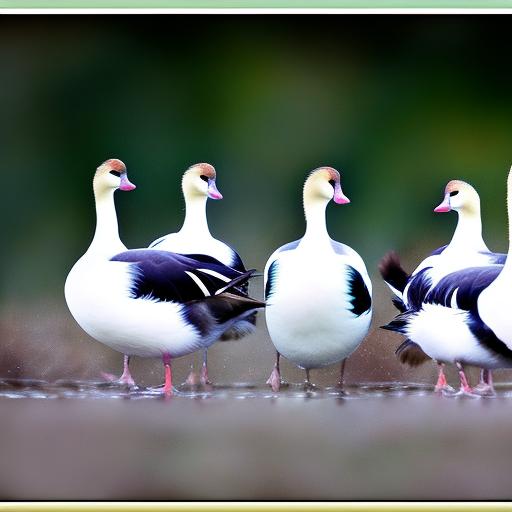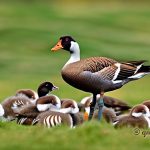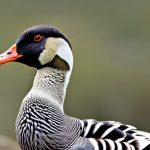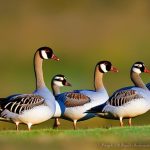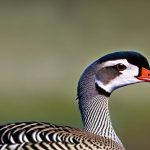Pomeranian Geese, also known as Pommern Geese or Pomeranians, are a breed of domestic geese that originated in the Pomerania region of Germany. They have a long history, dating back to the 18th century, and were originally bred for their meat and feathers. Over time, they have become a popular breed for both farmers and hobbyists due to their unique characteristics and benefits.
Pomeranian Geese are known for their excellent meat quality and high egg production. They are also relatively easy to care for, making them an ideal choice for those looking to raise geese for profit or as pets. Their friendly and docile nature also makes them a popular choice for families with children.
Key Takeaways
- Pomeranian Geese are a breed of domesticated geese that originated in Pomerania, a region in northern Europe.
- They are known for their distinctive appearance, with a white body, black head and neck, and orange beak and feet.
- Breeding Pomeranian Geese can provide benefits such as meat, eggs, feathers, and weed control.
- When choosing breeding stock, it is important to select healthy birds with desirable traits such as good egg production and temperament.
- Proper housing and feeding are essential for the health and well-being of Pomeranian Geese, and breeding season typically occurs in the spring.
Characteristics of Pomeranian Geese
Pomeranian Geese are medium-sized birds with a distinctive appearance. They have a compact body, a short neck, and a small head. Their feathers are typically white or gray, with some individuals having black markings on their wings and tail. They have a strong and sturdy build, which allows them to withstand harsh weather conditions.
In terms of temperament, Pomeranian Geese are known for being calm and friendly. They are not aggressive and can be easily handled, making them suitable for families with children or those who are new to raising geese. They are also highly intelligent and can be trained to follow simple commands.
One of the unique traits that set Pomeranian Geese apart from other breeds is their ability to fly. While most domestic geese have been bred to be flightless, Pomeranians still retain their natural ability to fly short distances. This can be both an advantage and a challenge for owners, as it allows the geese to roam freely but also requires proper fencing to prevent them from flying away.
Benefits of Breeding Pomeranian Geese
There are several benefits to breeding Pomeranian Geese. Firstly, there is a high demand for their meat and eggs. Pomeranian Geese are known for their flavorful and tender meat, which is often compared to that of a duck. Their eggs are also highly prized for their rich flavor and large size.
Another benefit of breeding Pomeranian Geese is that they are relatively low maintenance and easy to care for. They are hardy birds that can adapt to a wide range of climates and environments. They require minimal shelter and can graze on grass and other vegetation for most of their diet. This makes them a cost-effective choice for farmers and hobbyists.
Breeding Pomeranian Geese also has the potential for profit and sustainability. With the increasing demand for locally sourced and ethically raised meat and eggs, there is a growing market for Pomeranian Geese products. By breeding these geese, farmers can tap into this market and generate income while also promoting sustainable farming practices.
Choosing the Right Breeding Stock
When selecting geese for breeding, there are several factors to consider. Firstly, it is important to choose geese that are healthy and free from any genetic disorders or diseases. This can be done by conducting health screenings and genetic testing before breeding.
It is also important to consider genetic diversity when selecting breeding stock. Inbreeding can lead to a decrease in fertility and overall health of the offspring. By introducing new bloodlines into the breeding program, breeders can ensure the long-term viability of the breed.
Additionally, it is important to choose geese that exhibit the desired traits and characteristics of the breed. This includes selecting geese with good meat quality, high egg production, and a friendly temperament. By carefully selecting breeding stock, breeders can improve the overall quality of the flock and ensure the production of healthy and desirable offspring.
Housing and Feeding Requirements for Pomeranian Geese
Pomeranian Geese are relatively low maintenance and can be housed in a variety of environments. They require a sheltered area to protect them from extreme weather conditions, such as wind and rain. This can be a simple shed or coop with adequate ventilation and protection from predators.
In terms of feeding, Pomeranian Geese are primarily grazers and can obtain most of their diet from grazing on grass and other vegetation. However, it is important to supplement their diet with a balanced feed to ensure they receive all the necessary nutrients. This can include a commercial poultry feed or a homemade mix of grains, vegetables, and protein sources.
It is also important to provide fresh water at all times, as geese require a significant amount of water for digestion and overall health. This can be provided through a shallow dish or a small pond if available.
Breeding Season and Egg Production

Pomeranian Geese typically breed in the spring, with egg production peaking during this time. The breeding season can vary depending on the climate and geographical location, but generally occurs between February and May.
Female geese, known as hens, will lay an average of 20-30 eggs per year. The eggs are large and have a creamy white color. They have a long incubation period of around 28-35 days, during which the female will sit on the eggs to keep them warm.
It is important to note that not all eggs will be fertile, as geese require a male, known as a gander, for successful fertilization. Therefore, it is recommended to have one gander for every 4-6 hens to ensure optimal fertility rates.
Hatching and Raising Pomeranian Goslings
Hatching and raising Pomeranian goslings can be an exciting but challenging process. It is important to provide a suitable nesting area for the female to lay her eggs and incubate them. This can be a simple nest box filled with straw or hay.
Once the eggs hatch, it is important to provide a warm and safe environment for the goslings. This can be achieved through a brooder box or a heated area within the shelter. The temperature should be kept around 95-100 degrees Fahrenheit for the first week and gradually decreased as the goslings grow.
Feeding goslings is similar to feeding adult geese, with a focus on providing a balanced diet that includes a mix of grains, vegetables, and protein sources. It is important to provide fresh water at all times and monitor their growth and development closely.
Common challenges in raising goslings include ensuring proper nutrition, preventing diseases, and protecting them from predators. It is important to provide a clean and sanitary environment, regularly check for signs of illness, and implement appropriate predator control measures.
Health Issues and Common Diseases in Pomeranian Geese
Pomeranian Geese are generally hardy birds that are resistant to many common poultry diseases. However, they can still be susceptible to certain health issues and diseases.
One common health issue in geese is angel wing, which is a deformity of the wing joints that causes the wings to stick out instead of lying flat against the body. This can be caused by a high-protein diet or improper nutrition. It is important to provide a balanced diet and monitor the protein levels to prevent this condition.
Another common health issue in geese is bumblefoot, which is an infection of the foot caused by bacteria entering through small cuts or abrasions. This can be prevented by providing clean and dry living conditions and regularly inspecting the feet for any signs of injury or infection.
Other common diseases that can affect Pomeranian Geese include avian influenza, Newcastle disease, and duck viral enteritis. It is important to implement biosecurity measures, such as proper sanitation and quarantine protocols, to prevent the spread of these diseases.
Marketing and Selling Pomeranian Geese
When it comes to marketing and selling Pomeranian Geese, it is important to identify the right market and target audience. There is a growing demand for locally sourced and ethically raised meat and eggs, making Pomeranian Geese products appealing to consumers.
One strategy for marketing Pomeranian Geese is to focus on the unique characteristics and benefits of the breed. This can include highlighting their excellent meat quality, high egg production, and friendly temperament. It is also important to emphasize the sustainable farming practices used in raising these geese.
Finding the right market can be done through various channels, such as farmers markets, local restaurants, and online platforms. It is important to establish relationships with potential buyers and educate them about the breed and its benefits. Offering samples or hosting farm tours can also help generate interest and increase sales.
Conclusion and Future of Pomeranian Goose Breeding
In conclusion, breeding Pomeranian Geese can be a rewarding venture for both farmers and hobbyists. They are a popular breed due to their excellent meat quality, high egg production, and friendly temperament. They are relatively low maintenance and easy to care for, making them an ideal choice for those looking to raise geese for profit or as pets.
Choosing the right breeding stock is crucial for maintaining the health and genetic diversity of the flock. Providing suitable housing and feeding requirements is essential for the well-being of the geese. Breeding season typically occurs in the spring, with average egg production and incubation periods.
Raising goslings can be challenging but rewarding, with a focus on providing a warm and safe environment. Common health issues and diseases in Pomeranian Geese can be prevented through proper nutrition, sanitation, and biosecurity measures.
Marketing and selling Pomeranian Geese can be done through various channels, with a focus on highlighting the unique characteristics and benefits of the breed. The future of Pomeranian Goose breeding looks promising, with a growing demand for locally sourced and ethically raised meat and eggs. With proper care and management, Pomeranian Geese breeding has the potential for growth and sustainability.
If you’re interested in breeding Pomeranian geese, you might also find this article on duck mating season helpful. Understanding the mating season of ducks can provide valuable insights into the breeding patterns and behaviors of waterfowl. To learn more about when ducks mate and how it affects their reproductive cycle, check out this informative article: When is Duck Mating Season?
FAQs
What are Pomeranian geese?
Pomeranian geese are a breed of domestic geese that originated in Pomerania, a region in northern Europe. They are known for their small size, typically weighing between 6-8 pounds, and their distinctive white and gray feather pattern.
What is breeding Pomeranian geese?
Breeding Pomeranian geese involves selecting a male and female goose and allowing them to mate in order to produce offspring. This can be done naturally or through artificial insemination.
What is the purpose of breeding Pomeranian geese?
Breeding Pomeranian geese can be done for a variety of reasons, including for meat production, egg production, or as pets. Some breeders may also breed Pomeranian geese for show purposes.
What is the breeding season for Pomeranian geese?
The breeding season for Pomeranian geese typically begins in late winter or early spring, when the days start to get longer and the weather begins to warm up. Geese will typically mate and lay eggs during this time.
How many eggs do Pomeranian geese lay?
Pomeranian geese typically lay between 20-40 eggs per year, depending on the individual bird and the conditions in which they are kept. The eggs are typically white or cream-colored and are larger than chicken eggs.
How long does it take for Pomeranian geese eggs to hatch?
Pomeranian geese eggs typically take around 28-30 days to hatch, although this can vary depending on the individual bird and the conditions in which the eggs are kept. The eggs must be kept warm and turned regularly in order to ensure proper development.
What is the lifespan of Pomeranian geese?
Pomeranian geese can live for up to 20 years in captivity, although their lifespan can vary depending on factors such as diet, living conditions, and genetics. Proper care and nutrition can help to ensure a longer and healthier life for these birds.
Meet Walter, the feathered-friend fanatic of Florida! Nestled in the sunshine state, Walter struts through life with his feathered companions, clucking his way to happiness. With a coop that’s fancier than a five-star hotel, he’s the Don Juan of the chicken world. When he’s not teaching his hens to do the cha-cha, you’ll find him in a heated debate with his prized rooster, Sir Clucks-a-Lot. Walter’s poultry passion is no yolk; he’s the sunny-side-up guy you never knew you needed in your flock of friends!

